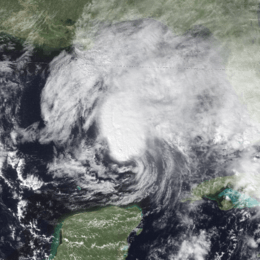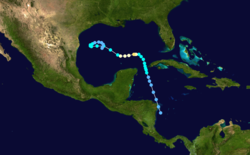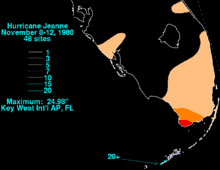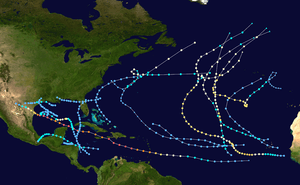Hurricane Jeanne (1980)
Hurricane Jeanne was a moderate hurricane that formed and dissipated in the Gulf of Mexico without making landfall. The tenth tropical cyclone and eighth hurricane of the 1980 Atlantic hurricane season, Jeanne developed over the southern Caribbean on November 7. It moved swiftly northward, and it intensified to a tropical storm on November 9. It entered the southern Gulf of Mexico on November 10. Jeanne turned to the west on November 11, and it rapidly intensified to its peak intensity of 100 mph (155 km/h). It weakened on November 12, and its forward motion slowed; the cyclone weakened further to a tropical storm because of dry air intrusion, and it executed a clockwise loop on November 15. It dissipated on November 16.
| Category 2 hurricane (SSHWS/NWS) | |
 Hurricane Jeanne at peak intensity in the Gulf of Mexico on November 11 | |
| Formed | November 7, 1980 |
|---|---|
| Dissipated | November 16, 1980 |
| Highest winds | 1-minute sustained: 100 mph (155 km/h) |
| Lowest pressure | 986 mbar (hPa); 29.12 inHg |
| Fatalities | None direct |
| Damage | Minimal |
| Areas affected | Gulf of Mexico, Key West, Florida coast |
| Part of the 1980 Atlantic hurricane season | |
At the time, Jeanne was one of three November hurricanes in the Gulf of Mexico; it was the first tropical cyclone to attain hurricane strength in the Gulf of Mexico during November.[1] The late season storm surprised maritime interests, and two barges broke free from towing vessels. Indirectly, the hurricane produced heavy precipitation that peaked at 23.28 inches (591 mm) in Key West. Minor beach erosion occurred along the Texas coast,[2] where tides were two to four feet above normal; coastal flooding affected the state, which was heavily impacted by tropical cyclones in August and September.[3] Jeanne caused no deaths.
Meteorological history

On the late afternoon of November 7, an area of disturbed weather organized to a tropical depression 60 miles (100 km) east of Atlántico Norte, Nicaragua.[4] Its origins were traced to a tropical wave that originated over western Africa on October 26.[1] Atmospheric conditions resembled an early fall pattern, and a large ridge was situated over the Gulf of Mexico and Southwestern United States. The depression moved northward into the Caribbean Sea, and the environment supported further development. On November 9, the depression strengthened to a 40 mph (65 km/h) tropical storm and was given the name Jeanne. Later, an Air Force reconnaissance aircraft reported a strengthening system; maximum sustained winds increased to 50 mph (80 km/h), and a minimum pressure of 999 mbar was measured.[1] The tropical cyclone moved northward into the southern Gulf of Mexico on November 10.[4] Jeanne's northward movement was blocked by the ridge, and the cyclone slowly turned to the west. On November 11, Jeanne quickly intensified to a minimal hurricane; later, it attained its peak intensity of 100 mph (155 km/h).[1]
On November 12, Jeanne weakened to a Category 1 hurricane.[4] It entered the western Gulf of Mexico, and its forward motion diminished as the ridge moved east.[1] Later, Jeanne diminished to a 65 mph (105 km/h) tropical storm. A developing trough remained west of Jeanne, and the cyclone was embedded in a weak pressure gradient. Although Jeanne briefly re-intensified to 70 mph (110 km/h), an advancing frontal boundary brought dry air over the western Gulf of Mexico. Jeanne weakened to a depression on November 14. It executed a clockwise loop, and it merged with the frontal boundary on November 16.[2]
Preparations
Some residents on Dauphin Island voluntarily evacuated, spurred by memories of 1979's Hurricane Frederic and Jeanne's northward motion. 3,000 workers evacuated their oil rigs because of Jeanne's high waves.[5][6] The National Hurricane Center advised small watercraft to remain in ports from Brownsville to Tarpon Springs. Forecasters expected tides of 2 feet above normal in Louisiana, which increased to 4 feet above normal along coastal Texas.[7] In Terrebonne and Lafourche parishes, schools were closed because of uncertainties regarding Jeanne's path.[6] The hurricane center also expected Jeanne to make landfall in southwestern Louisiana, although the hurricane eventually stayed offshore; thousands of residents moved inland, while Civil Defense officials remained alert. Forecasters expected locally heavy rainfall, although they suggested it would remain below 8 inches (203 mm).[8]
Impact

The combination of a large high pressure system and Jeanne produced rough seas over the northern Gulf of Mexico;[9] wave heights reached 15 feet (4.60 m).[5] On November 11, a ship reported sustained winds of 110 mph (175 km/h), although this reading was discarded and attributed to intense squalls.[2] In Key West, the storm's outer fringes produced a record-breaking 24-hour rainfall total of 23.28 inches (591 mm); 13.58 inches (345 mm) fell within six hours.[10] It remains the record 24-hour November rainfall total for the city as of 2018.[11] The previous record was set in 1954.[12] The heavy precipitation was attributed to a mesoscale feature;[1] an inflow band intersected with an adjacent stationary front, which also contributed to the deluge.[10] Schools and most businesses were closed, while flights were grounded at Key West International Airport; authorities urged residents to stay home. Telephone and power services were cut to some areas of the city.[12]
Elsewhere, several ships were caught off guard by the late arrival of Jeanne. The cyclone entered the Gulf of Mexico, and two barges broke loose from towing vessels via strong winds and high waves. One barge was an oil rig tender that contained 16 people; it was carried several hundred miles across the central Gulf of Mexico.[1] All crew members survived, and there were no maritime deaths related to the hurricane.[2] Jeanne produced a prolonged period of rough surf and heavy swells along the Texas coast. Tides reached 2 to 4 feet (1.20 m) above normal.[2] The hurricane caused coastal flooding; the worst flooding occurred near Galveston.[3]
Jeanne was one of only four tropical cyclones in the 20th century to attain hurricane status in the Gulf of Mexico without making landfall; the others were Laurie of 1969,[4] Henri of 1979,[13] and Alberto of 1982.[4]
See also
- List of Texas hurricanes
- Other storms of the same name
References
- NOAA (1980). "Hurricane Jeanne Preliminary Report: November 7–16, 1980". Retrieved November 12, 2007.
- NOAA (1980). "Jeanne Preliminary Report: Page 2". Retrieved November 13, 2007.
- United States Geological Service. "Summary of Significant Floods: 1970 through 1989". Archived from the original on September 25, 2006. Retrieved November 16, 2007.
- "Atlantic hurricane best track (HURDAT version 2)" (Database). United States National Hurricane Center. May 25, 2020.
- United Press International (1980). "Jeanne forces oil workers to leave rigs". The Chronicle Telegram. Retrieved November 13, 2007.
- The Associated Press (1980). "The Nation's Weather". Indiana Gazette. Retrieved November 14, 2007.
- The Associated Press (1980). "Jeanne Loses Hurricane Status". Indiana Gazette. Retrieved November 13, 2007.
- United Press International (1980). "Jeanne chases La. coastal residents inland". The Chronicle Telegram. Retrieved November 14, 2007.
- The Associated Press (1980). "Hurricane Jeanne Heads West". Marysville Journal-Tribune. Retrieved November 14, 2007.
- David Roth. "Hurricane Jeanne". Retrieved November 14, 2007.
- National Weather Service. "Key West, Florida November Climatology". Retrieved November 14, 2007.
- "23" of rain for Key West". Syracuse Herald Journal. Retrieved November 14, 2007.
- NOAA (1979). "Hurricane Henri: 14–24 September". Retrieved November 15, 2007.
